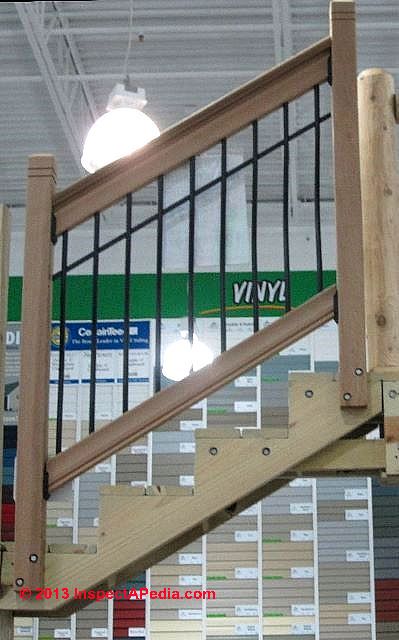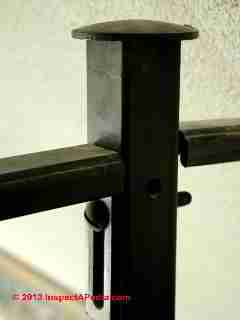 Metal Baluster Installation Procedure
Metal Baluster Installation Procedure
Deck Design-Build Online Guide
- POST a QUESTION or COMMENT about deck construction
Metal baluster choices & installation: this article describes options for choosing & installing commercial or site-built metal balusters in wood or other guardrail or stair railing assemblies.
This article series describes methods for design-build projects for decks and porches, including deck stairs and railings.
The page top photo shows my graddaughter Quinn Morgan Ascending stairs protected by metal guardrails but not designed for toddlers.
InspectAPedia tolerates no conflicts of interest. We have no relationship with advertisers, products, or services discussed at this website.
- Daniel Friedman, Publisher/Editor/Author - See WHO ARE WE?
Metal Deck Guardrail or Deck Rail Baluster Installation Procedures
Steps in Installing Metal Railing Balusters
 Metal balusters offer a distinctive look for your deck, and they are not difficult to install. Large home centers, suppliers of stair parts, and online vendors are good places to shop for a suitable product.
Metal balusters offer a distinctive look for your deck, and they are not difficult to install. Large home centers, suppliers of stair parts, and online vendors are good places to shop for a suitable product.
Powder- coated metal tubing can be found in several colors. An inch outside diameter is best. Some manufacturers offer matching post caps and decorative centerpieces to dress up the railing.
Type K or L copper tubing is another option that I've seen recommended by some writers but have never once encounterd in decades of deck & rail inspection. To use copper pipes as balusters, select 5/8-inch nominal tubing, which has a 3/4-inch outside diameter.
A railing made with metal balusters is easiest to build in sections, although it can also be built in place on the deck.
The main difference is that the rails are installed on edge, so that no dadoes are needed in the posts.
Begin by cutting the top and bottom rails to fit between the posts, then clamp them together on edge.
1. Prepare the Metal Baluster Mounting Holes
Calculate the baluster spacing. Instead of making a spacer as we discussed
at DECK RAIL BALUSTER INSTALL, however, mark an on-center layout for the balusters on the two rails.
To drill straight holes to a consistent 3/4-inch depth, use a drill guide or a drill press. Use a 3/4-inch Forstner bit.
2. Assemble the Metal Deck Railing
Unclamp the two rails, clean the chips out of the holes, and put a small amount of silicone caulk into each hole. Insert the balusters tightly into one rail, and then fit the other rail over the baluster ends.
With one rail clamped in place, use a hammer and a piece of wood to tap the other rail to ensure that all balusters are fully seated in their holes.
3. Attach the Metal Deck Railing Section
Lift the railing section into place. Fasten the rails to the posts with small angle brackets on the rail bottoms and screws or nails driven at an angle through the rail tops into the posts. If you like, install a 2x6 cap rail on flat
Watch out: as we illustrate below, with any guardrail and baluster system, connections are critical for the safety of the assembly.
Missing, incomplete, loose (photo at left), or improperly selected connectors risk a collapse of the railing and serious injury.
The photographs given here show a flimsy factory-assembled metal guardrail assembly that was modified by the owner during installation. This rail led to a nasty fall and serious injury.

...
Continue reading at HANDRAILS & HANDRAILINGS or select a topic from the closely-related articles below, or see the complete ARTICLE INDEX.
Or see these
Recommended Articles
- BALUSTER INSTALLATION
- BALUSTER INSTALLATION METAL
- HANDRAILS & HANDRAILINGS - home
- FALL HAZARDS DUE TO UN-GRASPABLE HANDRAILS
- GRASPABILITY of HANDRAILINGS
- HANDRAIL CODES & OSHA HAND RAIL SPECS
- HANDRAIL CODES - GRASPABILITY
- HANDRAIL CONTINUITY
- HANDRAIL EXTENSION REQUIREMENTS
- HANDRAIL GRASPABILITY DEFECT PHOTOS
- HANDRAILING STRENGTH
- HANDRAILS for WIDE STAIRWAYS
- SNAG HAZARDS on STAIRWAYS
- RAILING CODES & STANDARDS - home
- STAIR CODES & STANDARDS - home
- STAIR CODE DETAILS
Suggested citation for this web page
BALUSTER INSTALLATION METAL at InspectApedia.com - online encyclopedia of building & environmental inspection, testing, diagnosis, repair, & problem prevention advice.
Or see this
INDEX to RELATED ARTICLES: ARTICLE INDEX to STAIRS RAILINGS LANDINGS RAMPS
Or use the SEARCH BOX found below to Ask a Question or Search InspectApedia
Ask a Question or Search InspectApedia
Try the search box just below, or if you prefer, post a question or comment in the Comments box below and we will respond promptly.
Search the InspectApedia website
Note: appearance of your Comment below may be delayed: if your comment contains an image, photograph, web link, or text that looks to the software as if it might be a web link, your posting will appear after it has been approved by a moderator. Apologies for the delay.
Only one image can be added per comment but you can post as many comments, and therefore images, as you like.
You will not receive a notification when a response to your question has been posted.
Please bookmark this page to make it easy for you to check back for our response.
IF above you see "Comment Form is loading comments..." then COMMENT BOX - countable.ca / bawkbox.com IS NOT WORKING.
In any case you are welcome to send an email directly to us at InspectApedia.com at editor@inspectApedia.com
We'll reply to you directly. Please help us help you by noting, in your email, the URL of the InspectApedia page where you wanted to comment.
Citations & References
In addition to any citations in the article above, a full list is available on request.
- [1] Steve Bliss's Building Advisor at buildingadvisor.com helps homeowners & contractors plan & complete successful building & remodeling projects: buying land, site work, building design, cost estimating, materials & components, & project management through complete construction. Email: info@buildingadvisor.com
Steven Bliss served as editorial director and co-publisher of The Journal of Light Construction for 16 years and previously as building technology editor for Progressive Builder and Solar Age magazines. He worked in the building trades as a carpenter and design/build contractor for more than ten years and holds a masters degree from the Harvard Graduate School of Education. Excerpts from his recent book, Best Practices Guide to Residential Construction, Wiley (November 18, 2005) ISBN-10: 0471648361, ISBN-13: 978-0471648369, appear throughout this website, with permission and courtesy of Wiley & Sons. Best Practices Guide is available from the publisher, J. Wiley & Sons, and also at Amazon.com - [3] Prescriptive Residential Wood Deck Construction Guide, based on the 2009 International Residential Code, American Forest & Paper Association, Inc., provided by reader Mark Morsching from Everflashing.
- [2] Manual for the Inspection of Residential Wood Decks and Balconies, by Cheryl Anderson, Frank Woeste (Forest Products Society), & Joseph Loferski, October 2003, ISBN-13: 978-1892529343,
- In addition to citations & references found in this article, see the research citations given at the end of the related articles found at our suggested
CONTINUE READING or RECOMMENDED ARTICLES.
- Carson, Dunlop & Associates Ltd., 120 Carlton Street Suite 407, Toronto ON M5A 4K2. Tel: (416) 964-9415 1-800-268-7070 Email: info@carsondunlop.com. Alan Carson is a past president of ASHI, the American Society of Home Inspectors.
Thanks to Alan Carson and Bob Dunlop, for permission for InspectAPedia to use text excerpts from The HOME REFERENCE BOOK - the Encyclopedia of Homes and to use illustrations from The ILLUSTRATED HOME .
Carson Dunlop Associates provides extensive home inspection education and report writing material. In gratitude we provide links to tsome Carson Dunlop Associates products and services.


